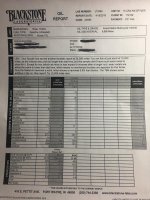OK, here's my question. Many of the answers above and elsewhere around on various forums on the Internet say to change the oil before putting a vehicle into winter storage. The rationale is that acids and other contamination can be corrosive so it's best to have good clean oil for the storage period. That all sounds reasonable. But, and it's a big BUT!
Fresh oil starts out with a Total Base Number (TBN) of anywhere from about 6 to 15 depending on brand and formulation. That is the concentration in milligrams of potassium hydroxide per gram of oil (mg KOH/g). KOH is a base, which is the opposite of acid. The reason for the base is to counteract or neutralize the acids that result from combustion. The general recommendation is that oil needs to changed, or at least partially changed or topped off, when the TBN drops to a range of 3 to 1. What does that mean? It means that the acid that contaminates the oil is neutralized, i.e., is no longer acidic. The ability of the oil to neutralize the acids starts to get inadequate the closer to 0 the TBN falls to. If the oil is still non-acidic at the end of the summer riding season then why is there a concern about acid eating away at the engine during storage? There doesn't need to be.
Look at the two oil reports in the thread I link to in my post above. The oil sample taken in April 2018 still had a TBN of 4.4 after nearly 11k miles and sitting over the winter. In other words, there was no acidity in the oil. The second sample in March 2019 had a TBN of 7.2 after 4200 miles and winter storage. That means it still has a lot of capacity to neutralize acids.
Acid levels (Total Acid Number or TAN) are generally measured only for transmission oils and gear lubricants. The fact that there is no acid level reading on oil analysis reports for gasoline and diesel engines is a clear indication that acid level is of concern only to the extent by which the ability of the oil to neutralize it, i.e., the TBN, has diminished, hence the importance of the TBN.
What we need in this discussion of oils is a comparison among all the members who have had oil analysis performed, is a chart showing the TBN of various oils at time of oil change at whatever miles it was changed. If, at the end of the summer your miles on the oil is well below the mileage at which the TBN for that oil is at 3 or less, there is no need to change it, either before or after winter storage.
Here's a quote from this oil analysis lab:
https://www.blackstone-labs.com/mot...abs.net/Bstone/(S(ezju2fvxon2xgwmybagyie55))/

